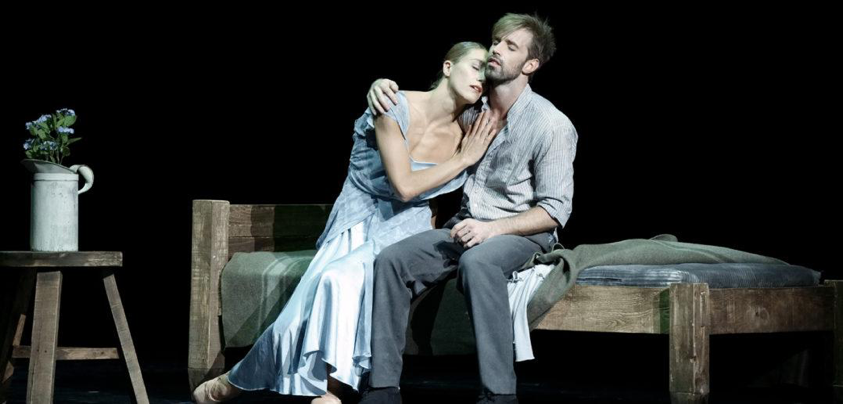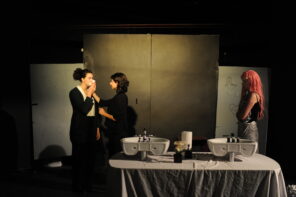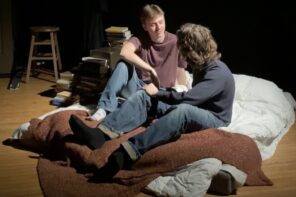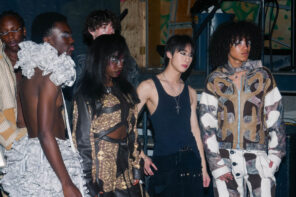The late McGill law professor F. R. Scott can be credited with the public’s current ability to savor Les Grands Ballets’ performance of Lady Chatterley’s Lover. Dr. Scott successfully convinced the Supreme Court of Canada to uncensor the D. H. Lawrence novel in 1962, after it was banned in Canada, the United Kingdom, the United States, Australia, India, and Japan for its unabashed use of “fuck” and pornographically precise description of an affair between upper-class Lady “Connie” Chatterley (Éline Malègue) and Oliver Mellors (Raphaël Bouchard), her husband’s gamekeeper. When Clifford Chatterley (Dane Holland) returns from WWI paralyzed from the waist down, Connie begins to feel sexually disenfranchised and is pulled to Oliver.
Remarkably, choreographer Cathy Marston’s ballet adaptation for Les Grands Ballets is not ribald, or even risqué. Her choreographic style is raw enough to not require a guise of violently erotic pas de deuxs or sustained eye contact so common in carnal ballets. No step appears premeditated, and the tone is all the more seductive for it. The chemistry between first soloist Malègue and soloist Bouchard melds them into a liquid element in their sex scenes. Their pas de deuxs play out like an erotic fantasy; just as the music’s climax sounds near, the dancers alter positions in acrobatic lifts, the music then softening or further crescendoing. Despite the adrenaline rush they provide, these scenes are not without pause; the audience witnesses the after-sex moment, little more than lying and breathing as a single unit, the most satisfying conclusion one could ask for.
No step appears premeditated, and the tone is all the more seductive for it.
Malègue also proves to be an emotive performer on her own. In a brilliantly thought-out scene, Connie is chained to a chair as she portrays poignitism through a mere incline of the neck or an agonizing droop to the floor, hands still hooked onto a chair leg. The tethering is imaginative in its mirroring of Clifford’s confinement to his wheelchair and his PTSD of a past life.
While cranium-on-the-ground, palms-jerking-across-the-stage sequences abound, the ballet’s verisimilitude lies in the transition steps. Malègue’s three seconds of back-and-forth trembling bourrées produces a moment of unadulterated indecision, anxious pacing made into dance. She then undercuts herself forward with a series of tripping coupés in order to confront Clifford with her pregnancy. Holland’s lower-body limitations are overridden by his adeptness with his wheelchair; at times, watching him simply roll across the stage in a rage is gripping. The results are dead-on anthropomorphic sequences, meticulously executed like a nervous tick.
Other blocks of group choreography feel like unnecessary, arduous transitions. In the first act, the coal miners extend a few too many turned-in, flexed-footed arabesques. Unaided by looser-fitting costumes, movements like this give the appearance of tired dancers, rather than burnt-out blue collars. Act II’s group pieces, however, are nothing short of ichorous, an oozing progression of non-stop movement.
Minimalist scenery attracts all attention to the dancers. An inclined upstage adds a grand illusion of characters sliding downstage as they attempt to abscond the inescapable antagonists of desire. Futuristic bars of cool-toned light modernize the story, literally framing the drama as they descend and obstruct the dancers from full freedom.
Extended applause for demi-soloist Emma Garau Cima, who plays Hilda, Connie’s assertive sister, with unrelenting birr and zest. She is clearly comfortable carving space around herself and boasts a possession of her every move. Cima is a whip-smart firecracker of a performer who, at times, slightly outshines Malègue and Bouchard- an accomplished feat indeed.
Les Grands Ballets’ telling is romantically modern and jarringly stirring, as well as the company’s first performance under new executive director Marc Lalonde, who took over for Alain Dancyger in August. While I cannot speak to the quality difference between the two directors, I can affirm that watching Lady Chatterley’s Lover is an exceptional experience. If you wish to watch overtly profane acts unfold onstage, you will leave the theatre disappointed. If you yearn for sexuality in its entirety- eroticism, shame, solidarity, and a source of unrelenting sorrow- you will leave satiated, with a curious hunger for more.
Performances run October 11-13 at 8:00 p.m. at Place des Arts in Salle Wilfrid-Pelletier. Get tickets here.








